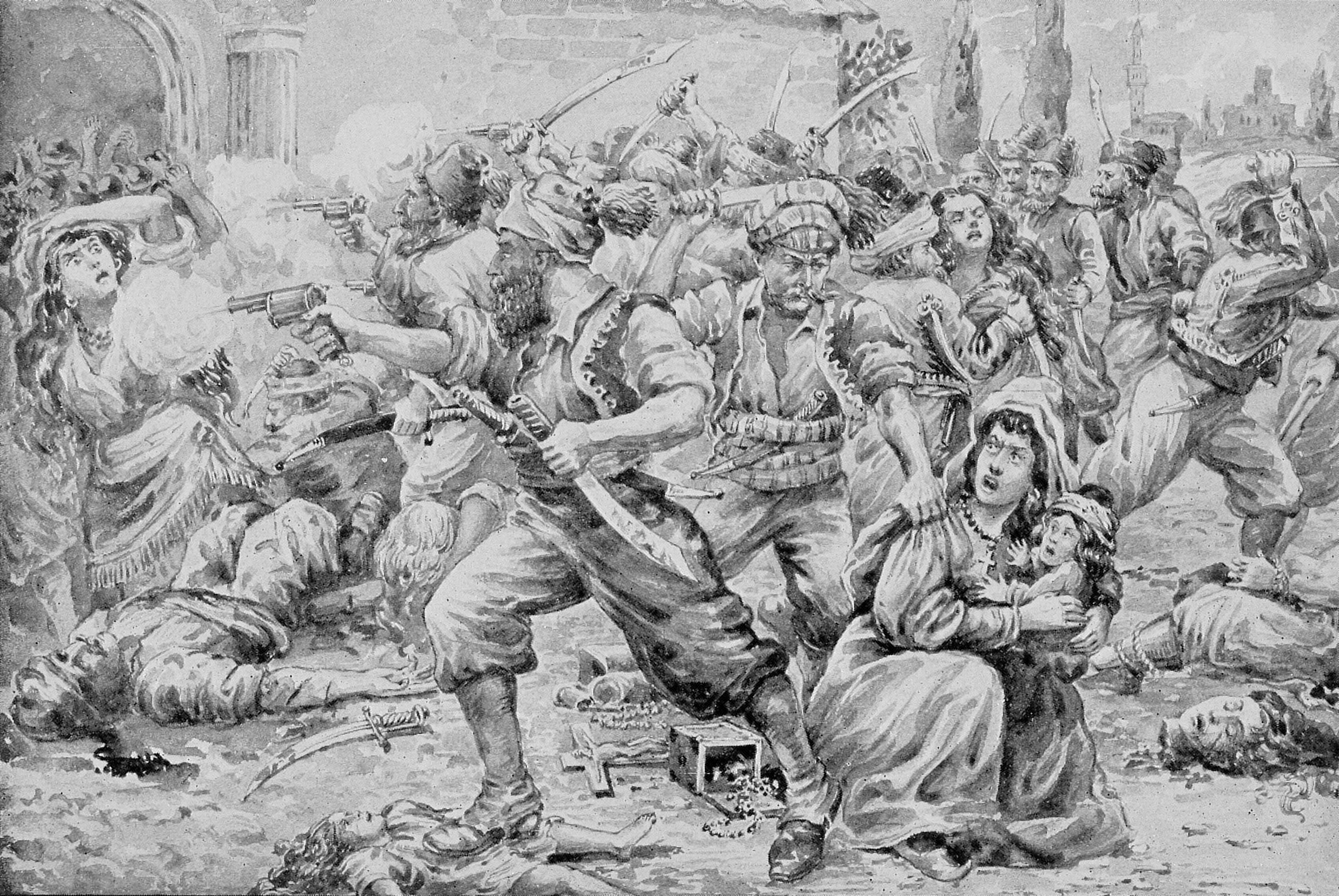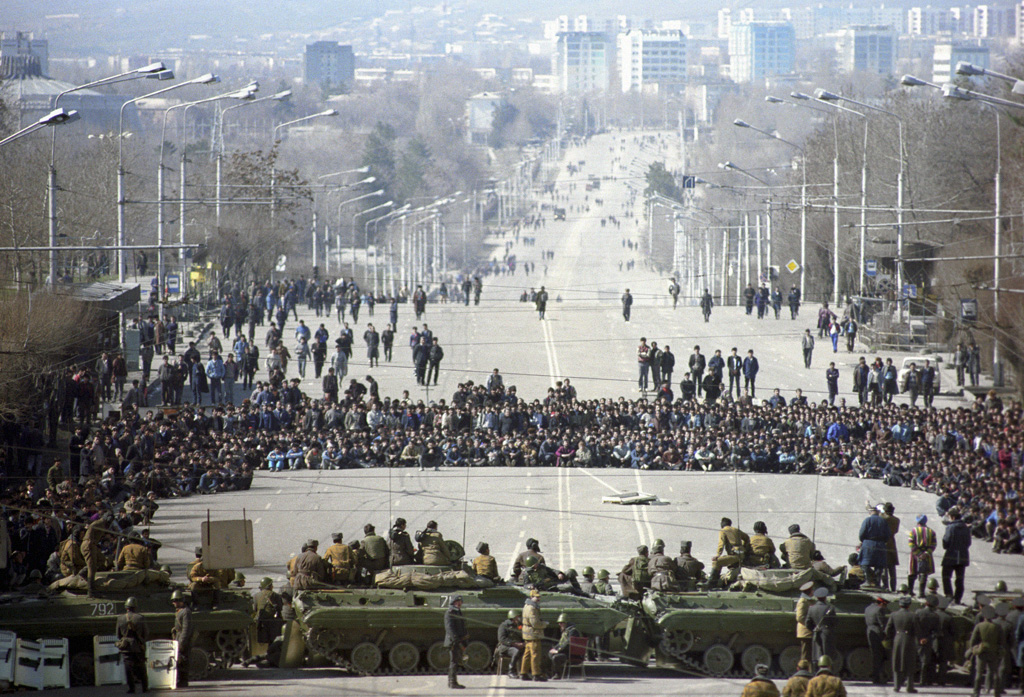|
1990 Dushanbe Riots
The 1990 Dushanbe riots were an anti-government unrest in Dushanbe, the capital of Tajikistan, from February 12–14, 1990. History In 1988, in the aftermath of the Sumgait pogrom and anti-Armenian riots in Azerbaijan, 39 Armenian refugees from Azerbaijan were temporarily resettled in Dushanbe. In 1990, the Armenian influx became a subject of the rumour that triggered riots in Dushanbe. The rumour inflated the number of refugees to 2,500–5,000. According to rumour Armenians allegedly were being resettled in new housing in Dushanbe, which was experiencing an acute housing shortage at that time. Despite the fact that Armenian refugees resettled not in public housing but with their relatives, and by 1990 had already left Tajikistan for Armenia, official denouncement of the rumours was not able to stop the protests. Assurances by First Secretary of the Communist Party of Tajikistan Qahhor Mahkamov that no resettlement of Armenians was taking place were rejected by the demo ... [...More Info...] [...Related Items...] OR: [Wikipedia] [Google] [Baidu] |
Dissolution Of The Soviet Union
The dissolution of the Soviet Union, also negatively connoted as rus, Разва́л Сове́тского Сою́за, r=Razvál Sovétskogo Soyúza, ''Ruining of the Soviet Union''. was the process of internal disintegration within the Soviet Union (USSR) which resulted in the end of the country's and its federal government's existence as a sovereign state, thereby resulting in its constituent republics gaining full sovereignty on 26 December 1991. It brought an end to General Secretary Mikhail Gorbachev's (later also President) effort to reform the Soviet political and economic system in an attempt to stop a period of political stalemate and economic backslide. The Soviet Union had experienced internal stagnation and ethnic separatism. Although highly centralized until its final years, the country was made up of fifteen top-level republics that served as homelands for different ethnicities. By late 1991, amid a catastrophic political crisis, with several republics alre ... [...More Info...] [...Related Items...] OR: [Wikipedia] [Google] [Baidu] |
Tajik Communist Party
The Communist Party of Tajikistan ( tg, Ҳизби Коммунистии Тоҷикистон, ''Hizbi Kommunistiyi Tojikiston''; russian: Коммунистическая партия Таджикистана) is a communist party in Tajikistan, and the oldest political party in the country. In the 2005 parliamentary election, the party won 13.97% of the popular vote and 4 out of 63 seats. The party is affiliated to the Union of Communist Parties – Communist Party of the Soviet Union. History Soviet era The first social democratic groups arose in Tajikistan during the 1905 Russian Revolution and by late 1917 and early 1918, Bolshevik organizations were created in Khodjent, Ura-Tyube, Penjikent, and Shurab. On December 6, 1924, the government formed the Organizing Bureau of the Central Committee of the Communist Party of Uzbekistan in the Tajik Autonomous Soviet Socialist Republic. The first Tajik party conference was held between October 21–27, 1927. On 25 November 1929, ... [...More Info...] [...Related Items...] OR: [Wikipedia] [Google] [Baidu] |
Protests In The Soviet Union
A protest (also called a demonstration, remonstration or remonstrance) is a public expression of objection, disapproval or dissent towards an idea or action, typically a political one. Protests can be thought of as acts of cooperation in which numerous people cooperate by attending, and share the potential costs and risks of doing so. Protests can take many different forms, from individual statements to mass demonstrations. Protesters may organize a protest as a way of publicly making their opinions heard in an attempt to influence public opinion or government policy, or they may undertake direct action in an attempt to enact desired changes themselves. Where protests are part of a systematic and peaceful nonviolent campaign to achieve a particular objective, and involve the use of pressure as well as persuasion, they go beyond mere protest and may be better described as a type of protest called civil resistance or nonviolent resistance. Various forms of self-expr ... [...More Info...] [...Related Items...] OR: [Wikipedia] [Google] [Baidu] |
Riots And Civil Disorder In The Soviet Union
A riot is a form of civil disorder commonly characterized by a group lashing out in a violent public disturbance against authority, property, or people. Riots typically involve destruction of property, public or private. The property targeted varies depending on the riot and the inclinations of those involved. Targets can include shops, cars, restaurants, state-owned institutions, and religious buildings. Riots often occur in reaction to a grievance or out of dissent. Historically, riots have occurred due to poverty, unemployment, poor living conditions, governmental oppression, taxation or conscription, conflicts between ethnic groups ( race riot) or religions (sectarian violence, pogrom), the outcome of a sporting event (sports riot, football hooliganism) or frustration with legal channels through which to air grievances. While individuals may attempt to lead or control a riot, riots typically consist of disorganized groups that are frequently "chaotic and exhibit herd ... [...More Info...] [...Related Items...] OR: [Wikipedia] [Google] [Baidu] |
Anti-Armenian Pogroms
Anti-Armenian sentiment, also known as anti-Armenianism and Armenophobia, is hostility to, prejudice towards, or discrimination against towards Armenians, Armenia, and Armenian culture. Historically, anti-Armenianism has manifested in several ways, ranging from expressions of hatred of or discrimination against individual Armenians to organized pogroms by mobs or state-sanctioned genocide. Notable instances or persecution include the Hamidean massacres (1894-1897), the Adana massacre (1909), the Armenian genocide (1915), the Stalinist Great Purge (1936-1938), and the Sumgait pogrom (1988). Modern anti-Armenianism is often expressed by opposition to the actions or existence of an Armenian state, aggressive denial of the Armenian genocide or belief in an Armenian conspiracy to fabricate history and manipulate public and political opinion for political gain. Anti-Armenianism has also manifested as extrajudicial killing or intimidation of people of Armenian heritage and destruc ... [...More Info...] [...Related Items...] OR: [Wikipedia] [Google] [Baidu] |
Ethnic Riots
An ethnic group or an ethnicity is a grouping of people who identify with each other on the basis of shared attributes that distinguish them from other groups. Those attributes can include common sets of traditions, ancestry, language, history, society, culture, nation, religion, or social treatment within their residing area. The term ethnicity is often times used interchangeably with the term nation, particularly in cases of ethnic nationalism, and is separate from the related concept of races. Ethnicity may be construed as an inherited or as a societally imposed construct. Ethnic membership tends to be defined by a shared cultural heritage, ancestry, origin myth, history, homeland, language, or dialect, symbolic systems such as religion, mythology and ritual, cuisine, dressing style, art, or physical appearance. Ethnic groups may share a narrow or broad spectrum of genetic ancestry, depending on group identification, with many groups having mixed genetic ancestry. Ethnic gr ... [...More Info...] [...Related Items...] OR: [Wikipedia] [Google] [Baidu] |
1990 In Tajikistan
Year 199 ( CXCIX) was a common year starting on Monday (link will display the full calendar) of the Julian calendar. At the time, it was sometimes known as year 952 ''Ab urbe condita''. The denomination 199 for this year has been used since the early medieval period, when the Anno Domini calendar era became the prevalent method in Europe for naming years. Events By place Roman Empire * Mesopotamia is partitioned into two Roman provinces divided by the Euphrates, Mesopotamia and Osroene. * Emperor Septimius Severus lays siege to the city-state Hatra in Central-Mesopotamia, but fails to capture the city despite breaching the walls. * Two new legions, I Parthica and III Parthica, are formed as a permanent garrison. China * Battle of Yijing: Chinese warlord Yuan Shao defeats Gongsun Zan. Korea * Geodeung succeeds Suro of Geumgwan Gaya, as king of the Korean kingdom of Gaya (traditional date). By topic Religion * Pope Zephyrinus succeeds Pope Victor I, as the ... [...More Info...] [...Related Items...] OR: [Wikipedia] [Google] [Baidu] |
Mass Murder In 1990
Mass is an intrinsic property of a body. It was traditionally believed to be related to the quantity of matter in a physical body, until the discovery of the atom and particle physics. It was found that different atoms and different elementary particles, theoretically with the same amount of matter, have nonetheless different masses. Mass in modern physics has multiple definitions which are conceptually distinct, but physically equivalent. Mass can be experimentally defined as a measure of the body's inertia, meaning the resistance to acceleration (change of velocity) when a net force is applied. The object's mass also determines the strength of its gravitational attraction to other bodies. The SI base unit of mass is the kilogram (kg). In physics, mass is not the same as weight, even though mass is often determined by measuring the object's weight using a spring scale, rather than balance scale comparing it directly with known masses. An object on the Moon would weigh less t ... [...More Info...] [...Related Items...] OR: [Wikipedia] [Google] [Baidu] |
1990 Riots
Year 199 ( CXCIX) was a common year starting on Monday (link will display the full calendar) of the Julian calendar. At the time, it was sometimes known as year 952 ''Ab urbe condita''. The denomination 199 for this year has been used since the early medieval period, when the Anno Domini calendar era became the prevalent method in Europe for naming years. Events By place Roman Empire * Mesopotamia is partitioned into two Roman provinces divided by the Euphrates, Mesopotamia and Osroene. * Emperor Septimius Severus lays siege to the city-state Hatra in Central-Mesopotamia, but fails to capture the city despite breaching the walls. * Two new legions, I Parthica and III Parthica, are formed as a permanent garrison. China * Battle of Yijing: Chinese warlord Yuan Shao defeats Gongsun Zan. Korea * Geodeung succeeds Suro of Geumgwan Gaya, as king of the Korean kingdom of Gaya (traditional date). By topic Religion * Pope Zephyrinus succeeds Pope Victor I, as the ... [...More Info...] [...Related Items...] OR: [Wikipedia] [Google] [Baidu] |
Civil War In Tajikistan
The Tajikistani Civil War ( tg, Ҷанги шаҳрвандии Тоҷикистон, translit=Jangi shahrvandiyi Tojikiston / Çangi shahrvandiji Toçikiston; russian: Гражданская война в Таджикистане), also known as the Tajik Civil War, began in May 1992 when regional groups from the Garm and Gorno-Badakhshan regions of Tajikistan rose up against the newly formed government of President Rahmon Nabiyev, which was dominated by people from the Khujand and Kulob regions. The rebel groups were led by a combination of liberal democratic reformers and Islamists, who would later organize under the banner of the United Tajik Opposition. The government was supported by Russian military and border guards. The main zone of conflict was in the country's south, although disturbances occurred nationwide. The civil war was at its peak during its first year and continued for five years, devastating the country. An estimated 20,000 to 150,000 people were killed i ... [...More Info...] [...Related Items...] OR: [Wikipedia] [Google] [Baidu] |
Turkmen Soviet Socialist Republic
The Turkmen Soviet Socialist Republic (, ; russian: Туркменская Советская Социалистическая Республика, ''Turkmenskaya Sovetskaya Sotsialisticheskaya Respublika''), also commonly known as Turkmenistan or Turkmenia, was one of the Republics of the Soviet Union, constituent republics of the Soviet Union located in Soviet Central Asia, Central Asia existed as a republic from 1925 to 1991. Initially, on 7 August 1921, it was established as the Turkmen Oblast of the Turkestan ASSR before being made, on 13 May 1925, a separate republic of the USSR as the Turkmen SSR. Since then the borders of the Turkmenia were unchanged. On 22 August 1990, Turkmenia declared its sovereignty over Soviet laws. On 27 October 1991, it became Turkmenistan, independent as Turkmenistan. Geographically, Turkmenia was bordered between Iran, Democratic Republic of Afghanistan, Afghanistan to the south, Caspian Sea to the west, the Kazakh Soviet Socialist Republic, Kaz ... [...More Info...] [...Related Items...] OR: [Wikipedia] [Google] [Baidu] |
.jpg)



